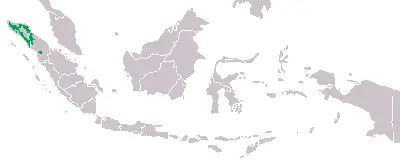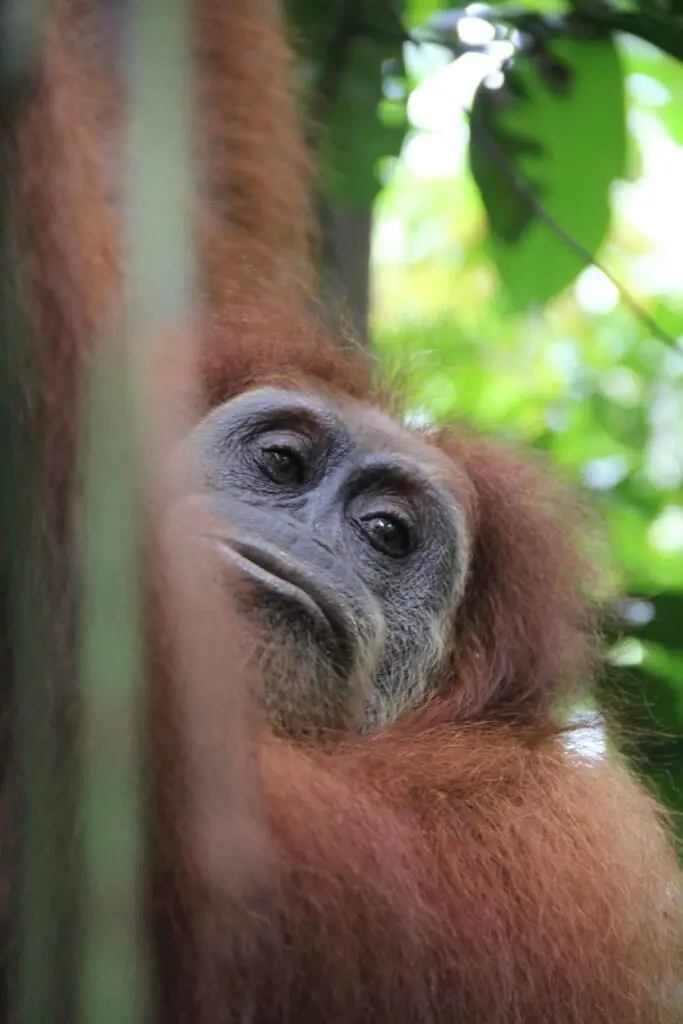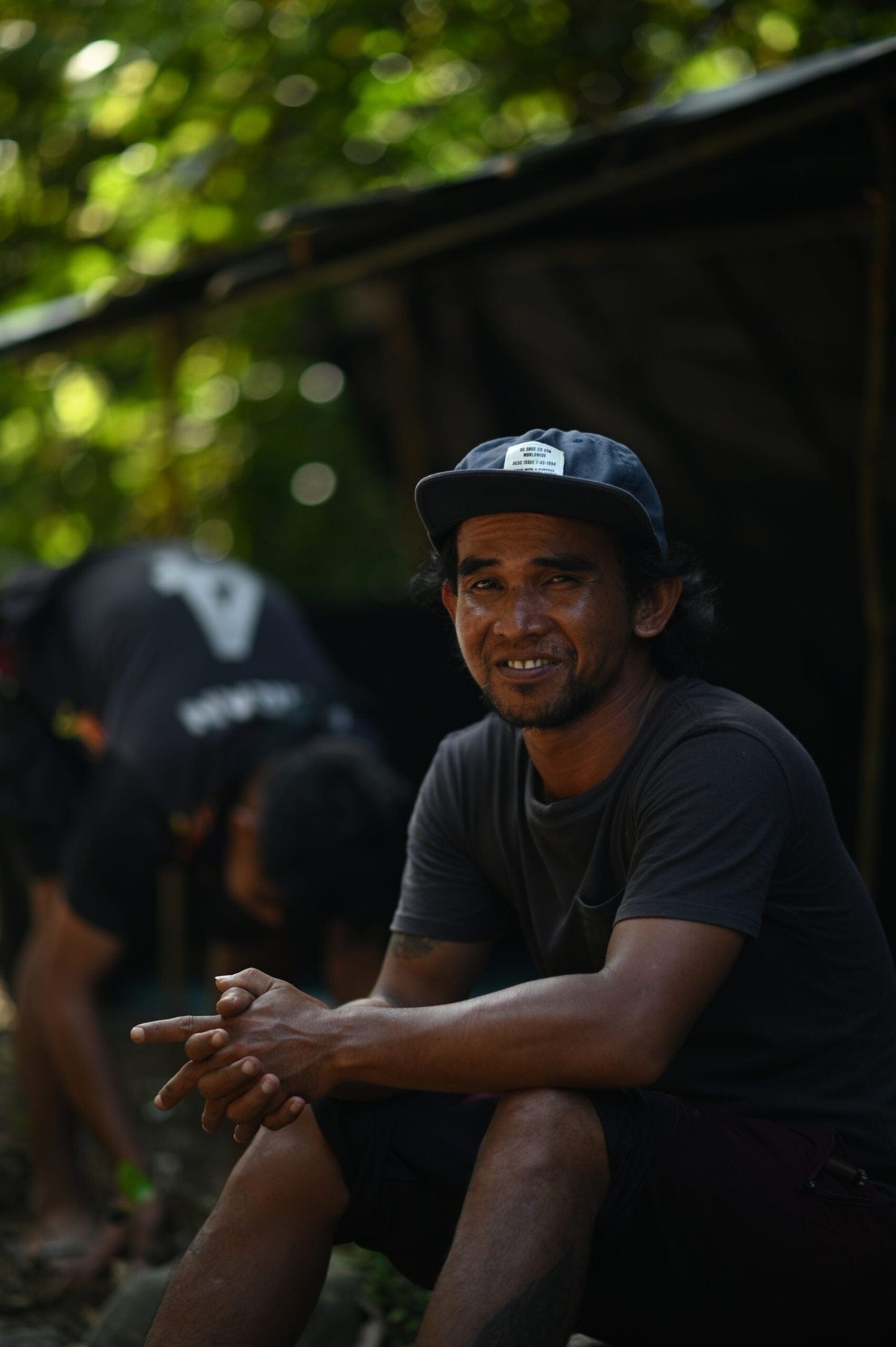Sumatran orangutan
The Sumatran orangutan (Pongo abelii ) is one of the three species of orangutans. Critically Endangered, and found only in the north of the Indonesian island of Sumatra, it is rarer than the Bornean orangutan but more common than the recently identified Tapanuli orangutan, also found in Sumatra. Its common name is based on two separate local words, “orang ” (“people” or “person”) and “hutan ” (“forest”), derived from Malay, and translates as ‘person of the forest’.
| KINGDOM | Animalia |
| PHYLUM | Chordata |
| CLASS | Mammalia |
| ORDER | Primates |
| SUBORDER | Haplorhini |
| INFRAORDER | Simiiformes |
| FAMILY | Hominidae |
| GENUS | Pongo |
| SPECIES | Pongo abelii |
| POPULATION SIZE | 14.000 |
| LIFE SPAN | 35-50 YRS |
| TOP SPEED | 6 KM/H |
| WEIGHT | 45-90 KG |
| HEIGHT | 90-140 CM |
| LENGTH | 1.3-1.8 M |
Appearance Sumatran Orangutan
Orangutans are the only great apes that live outside Africa. There are two kinds of orangutans. However, the Sumatran orangutan is more endangered than the Bornean orangutan. Also, the two types look and act differently.
For example, Sumatran orangutans are a bit smaller. Moreover, their hair is usually lighter and more orange-red. In addition, they have longer beards.
Male orangutans grow throat pouches and cheek pads. But in Sumatran males, these pads are thinner and less noticeable than in Bornean males.
Distribution
| CONTINENTS | Asia |
| SUBCONTINENTS | Southeast Asia |
| COUNTRIES | Indonesia |
| REGIONS | Sumatera |
| BIOGEOGRAPHICAL REALMS | Indomalayan |
| WWF BIOMES | Tropical moist forests |

Sumatran orangutans occur on Sumatra, in Indonesia, and are restricted to just the northern tip of the island. They live in primary lowland tropical forests, including mangrove, riparian forests and swamp forests.

Biome
| Forest | Rainforest |
| Riparian | Swamp Wetlands |
Climate zones
| Tropical |
Habits and Lifestyle Sumatran Orangutan
Sumatran orangutans live mostly alone. During the day, they move slowly through the trees to find food. They spend about 60% of their time looking for and eating food. Even though their home areas can be large, they usually travel only about half a mile each day.
At night, they build nests high up in the trees. They make these nests using folded branches. The nests are where they sleep.
Orangutans do not defend their territory strongly. They often share their space and sometimes eat near other orangutans. This happens especially when there is plenty of fruit.
Male orangutans use long, deep calls to mark their territory. These loud sounds come from a pouch in their throat. The calls help attract females and warn other males to keep away.
Diet and Nutrition Sumatran Orangutan
Sumatran orangutans eat different foods at different times of the year. They eat fruit when it is ripe. For example, figs are very important in their diet. However, during dry seasons, fruit is harder to find. So, they eat other plants like young leaves, bark, and flowers. They also eat insects such as termites, ants, and crickets. Sometimes, they eat eggs too.
DIET
| FRUGIVORE, HERBIVORE, |
Mating Habits
| MATING BEHAVIOR | Polygynandry |
| REPRODUCTION SEASON | December-May |
| PREGNANCY DURATION | 9 months |
| BABY CARRYING | 1 infant |
| INDEPENDENT AGE | 8-9 years |
| FEMALE NAME | female |
| MALE NAME | male |
| BABY NAME | infant |
Sumatran orangutans have a special mating system. It is called polygynandry. This means several males and females mate with each other. Most mating happens during the rainy season. This lasts from December to May. During this time, fruit is most plentiful. After about nine months of pregnancy, the female builds a nest high in a tree. She gives birth to one baby in the nest. The baby holds on to its mother for safety. It stays close to her for many years.
Young orangutans may stop nursing by age three. However, they usually stay with their mother until they are 8 or 9 years old. During this time, they learn how to live in the forest. Sumatran orangutans breed more slowly than most other primates. A female usually has no more than three babies in her life. Females can have babies by age 12. Males mature later, around age 19.
Population threats
The main threat to Sumatran orangutans is losing their habitat. These animals are very vulnerable because they have a long time between births—usually about eight years. This makes them the slowest-breeding primates in the world.
Recent political problems in their home areas have caused more illegal logging. This happens even in protected forests. Poachers also capture more baby orangutans. They sell these babies as illegal pets.
Population number Orangutan
According to the IUCN Red List, about 7,300 Sumatran orangutans live in the wild. Conservationists are working to start a new group in Jambi and Riau Provinces. This group lives in Bukit Tigapuluh National Park. It has about 70 orangutans and they are having babies.
Even with these efforts, the total number of Sumatran orangutans is still going down. The IUCN lists them as critically endangered. This means they are at very high risk of extinction.
Ecological niche
Sumatran orangutans play an important role in the lowland rainforests of Sumatra. Because of this, people consider them a keystone species. For example, they help the forest by spreading seeds and eating many types of fruit. This means they help keep the rainforest full of different kinds of trees.
In addition, orangutans help plants grow. They do this by pruning leaves and stems, since they eat only green parts of plants. As a result, their actions support new plant growth.
Orangutans are mostly solitary animals. Therefore, they spend most of their lives alone. However, in some areas, females sometimes gather in small groups. This happens more often during fruiting season, when food is easier to find. These group meetings help them socialise. Also, they use sounds, or vocalisations, to communicate with one another.
Orangutans produce vocalisations that differ from those of other primates. For instance, adult orangutans emit long-range calls to reach other individuals scattered throughout the dense rainforest. These vocalisations help define their social relationships and interactions, especially during reproduction. Moreover, orangutans use vocalisations to express complex emotions such as fear, aggression, and excitement.
Orangutans make many different sounds. One common sound is the grunt, which is like a low snort. Often, young males and females grunt while they play. In addition, males without cheek pads grunt to show they want to mate with a dominant female. Orangutans may also grunt when they meet others.
Another sound is the scream. This loud noise sounds like a frightened cry or a long wail. Baby orangutans often scream to ask for food or to show they want to nurse. Also, young orangutans scream when they feel scared or upset.
A third sound is the long call. This loud call echoes through the forest. Adult males with cheek pads use it to mark their territory. The call has two main purposes: it attracts females and warns other males to stay away. Furthermore, these calls can travel over 1.5 kilometres.
Sometimes, male orangutans make long calls when they are scared. For example, this can happen if a tree falls nearby. A long call has three parts. First, there is a short grunt or rumble. Next, a loud sound follows. Finally, it ends with a soft, gurgling noise. Often, the orangutan’s mouth looks frothy or bubbly during the call. But not all orangutans use all three parts. Some skip the grunt and start with the loud sound right away.




